 |
Quick Search |
 |
|
|
|
|
|
| Horse Colors And Variations |
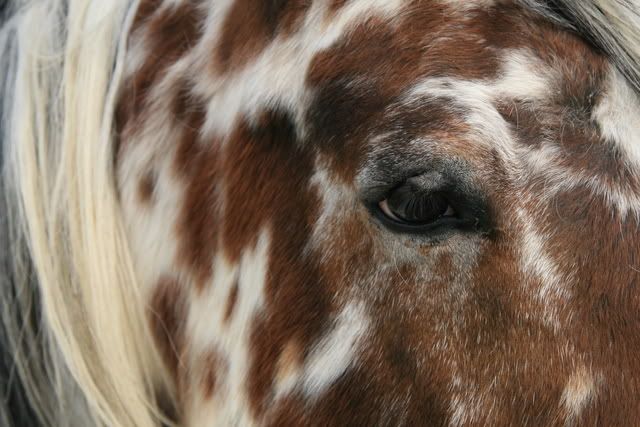

"A good horse is never a bad color..."
Horse colors and the genetics that produce them can be very complicated. All horse
colors are derived from two base colors: black or red. Derivatives of these two
colors form 17 basic horse colors: black,white, gray, brown, bay, chestnut, sorrel,
dun, red dun, buckskin, palomino, cremello, perlino, grullo, red roan, bay roan,
and blue roan. Different patterns of the basic colors make pinto, paint, appaloosa,
dapple, brindle, and other variations.
A black based colored horse is any horse that has black points (ears, mane, tail, and legs)
or is solid black. Blackbased colors are black, brown, bay, buckskin, grullo, perlino,
blue roan, and bay roan.
A red based colored horse won't have any black points,
even if the mane and tail appear dark. The red-based colors are chestnut, sorrel,
red dun, palomino, cremello, and red roan.
White markings result from an absence of pigment. Darker colors are caused by a
higher concentration of pigment, lighter colors result from a lesser concentration
of pigment. Perlinos and cremellos have pigment, but it's diluted. All white markings
are superimposed over a base body color, so when identifying a horse's color,
only the base color is considered.
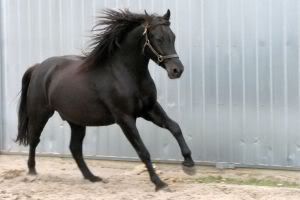 Black
True black horses are either a blue-black shade or a faded black color due to
sunlight exposure. Genetics cannot differentiate between the two. A dark brown or
bay horse may appear black, but if there are lighter colored hairs around the eyes,
muzzle, or flank area, it is not a true black. A smoky black is a horse that would be
black, except that it has a cream gene, and genetic test may be the only proof that it
is a dilute. Black horses are not born black, but are usually some shade of gray with
black mane, tail, dorsal stripe, and sometimes zebra stripes on the legs. When the
foal coat sheds, they will appear solid black.
Black
True black horses are either a blue-black shade or a faded black color due to
sunlight exposure. Genetics cannot differentiate between the two. A dark brown or
bay horse may appear black, but if there are lighter colored hairs around the eyes,
muzzle, or flank area, it is not a true black. A smoky black is a horse that would be
black, except that it has a cream gene, and genetic test may be the only proof that it
is a dilute. Black horses are not born black, but are usually some shade of gray with
black mane, tail, dorsal stripe, and sometimes zebra stripes on the legs. When the
foal coat sheds, they will appear solid black.
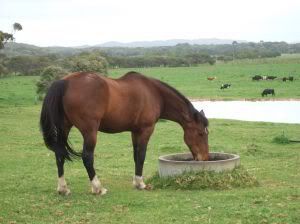 Bay
This color ranges from a light reddish-brown to a very
dark brown. Bay horses have black points, which are the
mane, tail, and lower legs. A very bright red color is referred
to as a Blood Bay.
Bay
This color ranges from a light reddish-brown to a very
dark brown. Bay horses have black points, which are the
mane, tail, and lower legs. A very bright red color is referred
to as a Blood Bay.

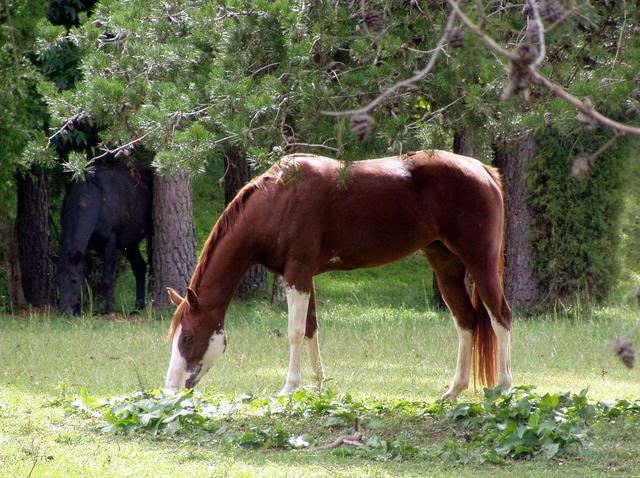 Chestnut and Sorrel
These terms are used to define different shades of the
same recessive red gene. The chestnut color has a darker hint, and can range
from mahogany to dark "liver" chestnut. The sorrel color appears reddish or copper
colored, and can range to light red. The mane, tail, and legs are usually the same
color as their body, but can have variations such as a flaxen (blonde) mane and
tail, or darker mane and tail, but never black.
Chestnut and Sorrel
These terms are used to define different shades of the
same recessive red gene. The chestnut color has a darker hint, and can range
from mahogany to dark "liver" chestnut. The sorrel color appears reddish or copper
colored, and can range to light red. The mane, tail, and legs are usually the same
color as their body, but can have variations such as a flaxen (blonde) mane and
tail, or darker mane and tail, but never black.
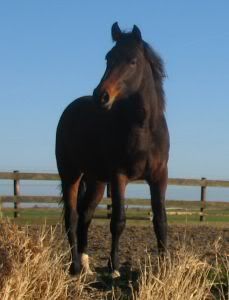 Brown
Brown colored horses are very dark, almost black. Their mane and
tail are the same dark color as their coat. Easily mistaken for black, the
brown color can usually be identified by lighter brown or tan hairs at the
muzzle, eyes, or flanks.
Brown
Brown colored horses are very dark, almost black. Their mane and
tail are the same dark color as their coat. Easily mistaken for black, the
brown color can usually be identified by lighter brown or tan hairs at the
muzzle, eyes, or flanks.
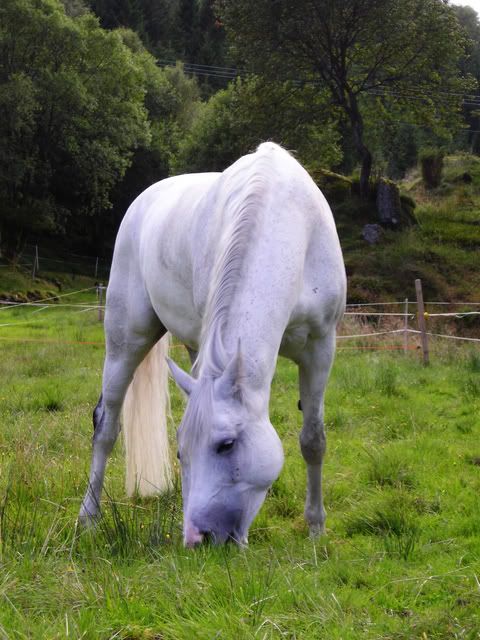
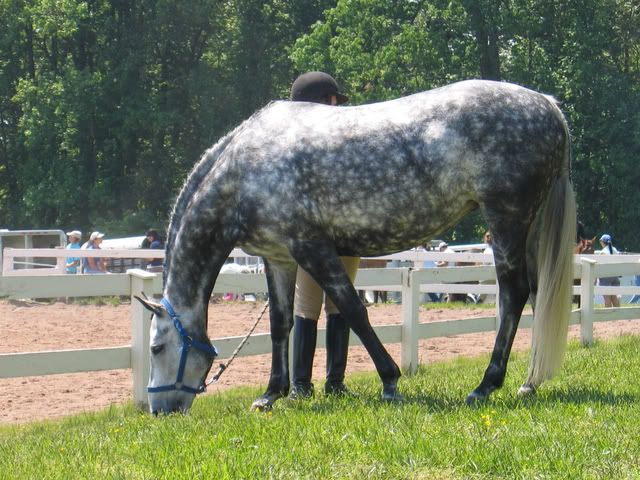 Gray
A gray horse has black skin and white or mixed dark and white hairs.
Gray horses can range from a dark salt-and-pepper gray called steeldust, to
dapple gray which has faint white spots, to rose gray which is a gray horse
with a reddish tinge to its coat, to flea-bitten gray which is mostly white with
small colored flecks in the coat, to a horse with a fully white hair coat. Gray
horses can be born any color, and will lighten as they age. A gray horse is
different from a white horse in that its skin is dark around the eyes, muzzle,
flanks, and other areas. A gray horse's base color can be anything on the
equine color spectrum, but the gray modifier progressively lightens the coat.
Because the gray modifier is dominant, it will eventually cover the original
color. Because gray is a dominant modifier, one or both of the foal's parents
must be gray. If a horse is gray, it has a 50% chance of passing the trait to its
offspring.
Gray
A gray horse has black skin and white or mixed dark and white hairs.
Gray horses can range from a dark salt-and-pepper gray called steeldust, to
dapple gray which has faint white spots, to rose gray which is a gray horse
with a reddish tinge to its coat, to flea-bitten gray which is mostly white with
small colored flecks in the coat, to a horse with a fully white hair coat. Gray
horses can be born any color, and will lighten as they age. A gray horse is
different from a white horse in that its skin is dark around the eyes, muzzle,
flanks, and other areas. A gray horse's base color can be anything on the
equine color spectrum, but the gray modifier progressively lightens the coat.
Because the gray modifier is dominant, it will eventually cover the original
color. Because gray is a dominant modifier, one or both of the foal's parents
must be gray. If a horse is gray, it has a 50% chance of passing the trait to its
offspring.
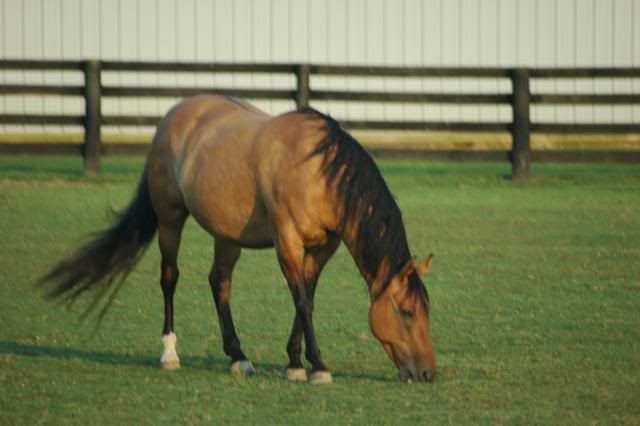 Dun
The dun gene is another dominant modifier that can appear on both black
and red based horses. It affects the shade of the horse's coat and adds the dun
characteristics, which are a dorsal stripe, zebra stripes on the legs, striping over
the withers, dark tips on the ears, and a darker coloration on the lower legs. The
classic dun color is a golden tan color with black points, a black dorsal stripe, and
zebra stripes on the legs. It can easily be confused with the color buckskin
because the appearance is very similar, but the genetics are different.
Dun
The dun gene is another dominant modifier that can appear on both black
and red based horses. It affects the shade of the horse's coat and adds the dun
characteristics, which are a dorsal stripe, zebra stripes on the legs, striping over
the withers, dark tips on the ears, and a darker coloration on the lower legs. The
classic dun color is a golden tan color with black points, a black dorsal stripe, and
zebra stripes on the legs. It can easily be confused with the color buckskin
because the appearance is very similar, but the genetics are different.
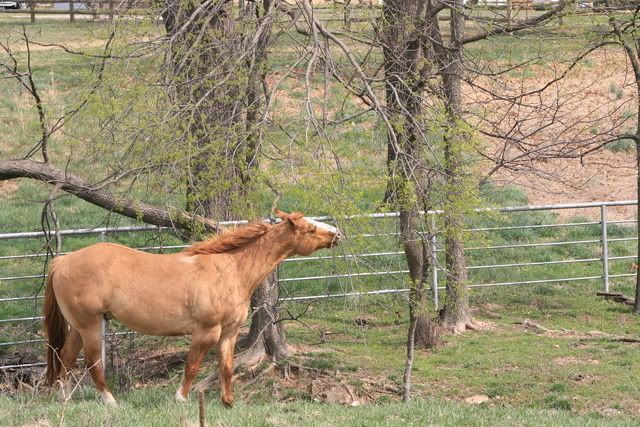 Red Dun
A sorrel horse that has the dun modifier is called a red dun, and will appear in
shades of pale red to light tan, but never has black points. Its mane and tail can
range from cream colored to a dark reddish color. It will show some or all of the
dun characteristics.
Red Dun
A sorrel horse that has the dun modifier is called a red dun, and will appear in
shades of pale red to light tan, but never has black points. Its mane and tail can
range from cream colored to a dark reddish color. It will show some or all of the
dun characteristics.
 Buckskin
A buckskin horse is a bay horse with a single dose of the cream dilution. The dilution
causes the coat color to golden, but does not affect the point, which remain
black. Buckskins have a 50% chance of passing on its dilute color to its progeny.
The buckskin color can range from cream, yellow, or dark, or "smutty" buckskin.
Buckskin
A buckskin horse is a bay horse with a single dose of the cream dilution. The dilution
causes the coat color to golden, but does not affect the point, which remain
black. Buckskins have a 50% chance of passing on its dilute color to its progeny.
The buckskin color can range from cream, yellow, or dark, or "smutty" buckskin.
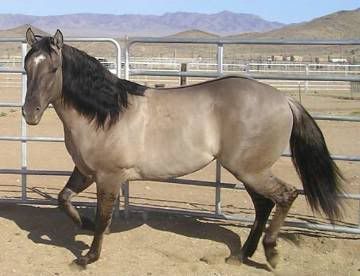 Grulla
The grulla color consists of a black horse with
the dun modifier. This color can be silvery, smoky, or a
mouse color. Each of the hairs will have the silvery color, it
is not a mix of light hairs and dark hairs. Grulla horses also
have the dun characteristics.
Grulla
The grulla color consists of a black horse with
the dun modifier. This color can be silvery, smoky, or a
mouse color. Each of the hairs will have the silvery color, it
is not a mix of light hairs and dark hairs. Grulla horses also
have the dun characteristics.
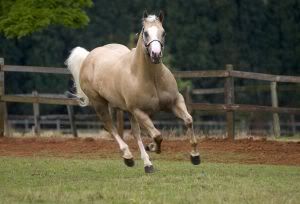 Palomino
A palomino is a sorrel horse that has a single copy of the cream
dilution. Palomino colors range from chocolate, deep gold, to blonde, to pale
cream. Their mane and tail is always a color ranging from blonde to white.
Palomino
A palomino is a sorrel horse that has a single copy of the cream
dilution. Palomino colors range from chocolate, deep gold, to blonde, to pale
cream. Their mane and tail is always a color ranging from blonde to white.
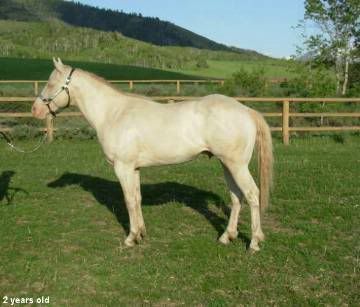
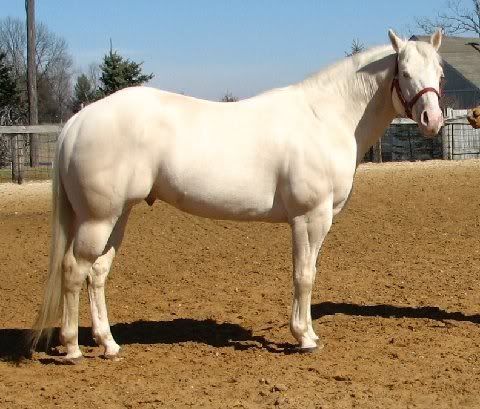 Cremello
A cremello is a sorrel horse with two copies of the cream dilution. This results in a
horse with a nearly white coat, blue eyes, and pale or pink skin. A double dilute such
as the cremello will always produce a dilute foal. For example, a cremello bred to a
sorrel will produce a palomino.
Cremello
A cremello is a sorrel horse with two copies of the cream dilution. This results in a
horse with a nearly white coat, blue eyes, and pale or pink skin. A double dilute such
as the cremello will always produce a dilute foal. For example, a cremello bred to a
sorrel will produce a palomino.
Perlino
A perlino is a bay horse with two copies of the cream dilution. The
coat color is changed to pale cream, and the points are diluted to tan or orange.
A perlino horse usually has blue eyes and pale skin.
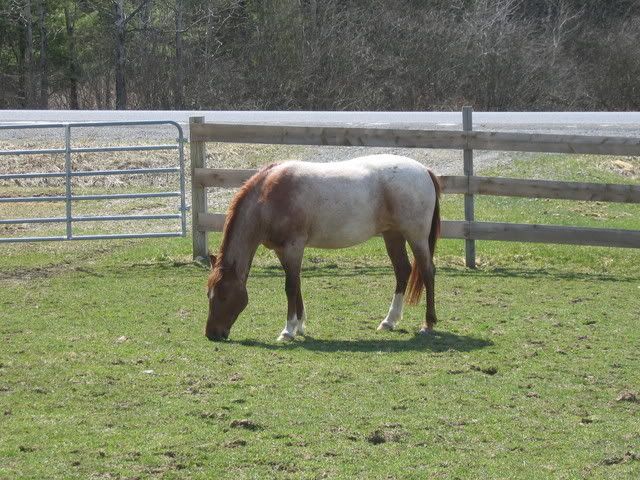 Roan
A roan horse has a mixture of white and any other color hairs. The
hairs are evenly intermixed over the body. Roans usually have darker or solid colored
heads. Roan horses usually do not fade or lighten like gray horses do.
Roan
A roan horse has a mixture of white and any other color hairs. The
hairs are evenly intermixed over the body. Roans usually have darker or solid colored
heads. Roan horses usually do not fade or lighten like gray horses do.
Red roan is a chestnut base color with a mixture of
white hairs throughout, the mane and tail will be the same red as the body.
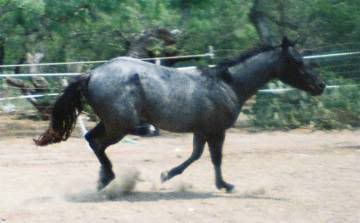 A blue roan will have a uniform mixture of white and black hairs on its body,
with black mane and tail.
A blue roan will have a uniform mixture of white and black hairs on its body,
with black mane and tail.
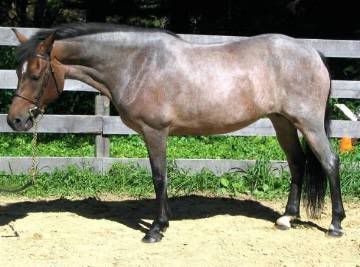 A bay roan has a bay base coat and white hairs mixed throughout. The mane
and tail will be black.
A bay roan has a bay base coat and white hairs mixed throughout. The mane
and tail will be black.
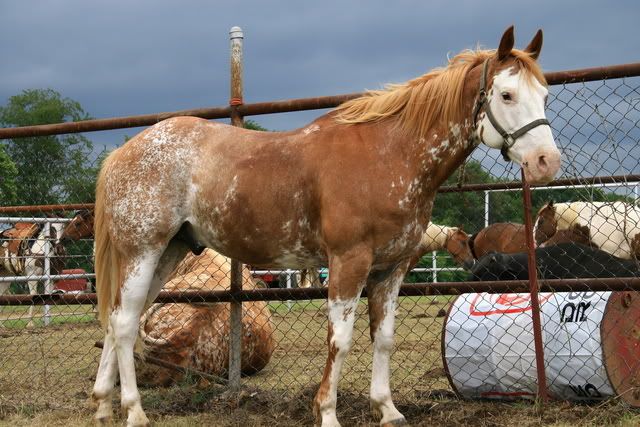 A rabicano is a roan-like effect that is caused by a genetic
modifier that creates a splotchy roaning pattern on only a portion of the body.
The rest of the body will not have white hairs throughout, and the legs or head
are not darker than the rest of the coat. A rabicano is only a roan in spots or
splashes.
A rabicano is a roan-like effect that is caused by a genetic
modifier that creates a splotchy roaning pattern on only a portion of the body.
The rest of the body will not have white hairs throughout, and the legs or head
are not darker than the rest of the coat. A rabicano is only a roan in spots or
splashes.
"Horse Color Variations"
Over the base colors mentioned above, there are various patterns of white that
form the characteristics of different breeds or colors. Even the rarer colors
of roan, grulla, and palomino can be patterned over with white on a pinto horse
or appaloosa horse.
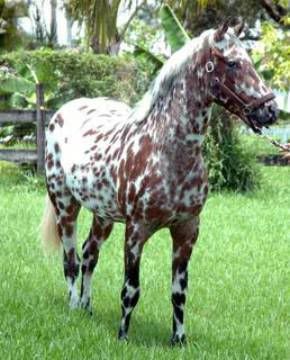
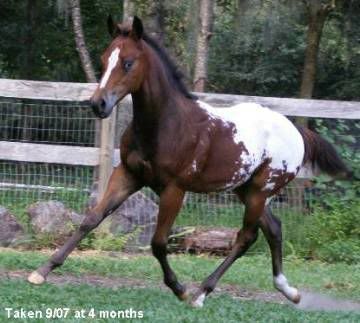 Appaloosa
An appaloosa horse has a solid base color with speckles. It can
be a colored base with white speckles either over the whole body or in certain
areas such as over the back and hindquarters. Leopard appaloosas have a
white or gray body with black or colored spots over the entire body.
Recognized appaloosa coat patterns include blanket, frost, leopard, few-spot
leopard, marble, and snowflake.
Appaloosa
An appaloosa horse has a solid base color with speckles. It can
be a colored base with white speckles either over the whole body or in certain
areas such as over the back and hindquarters. Leopard appaloosas have a
white or gray body with black or colored spots over the entire body.
Recognized appaloosa coat patterns include blanket, frost, leopard, few-spot
leopard, marble, and snowflake.
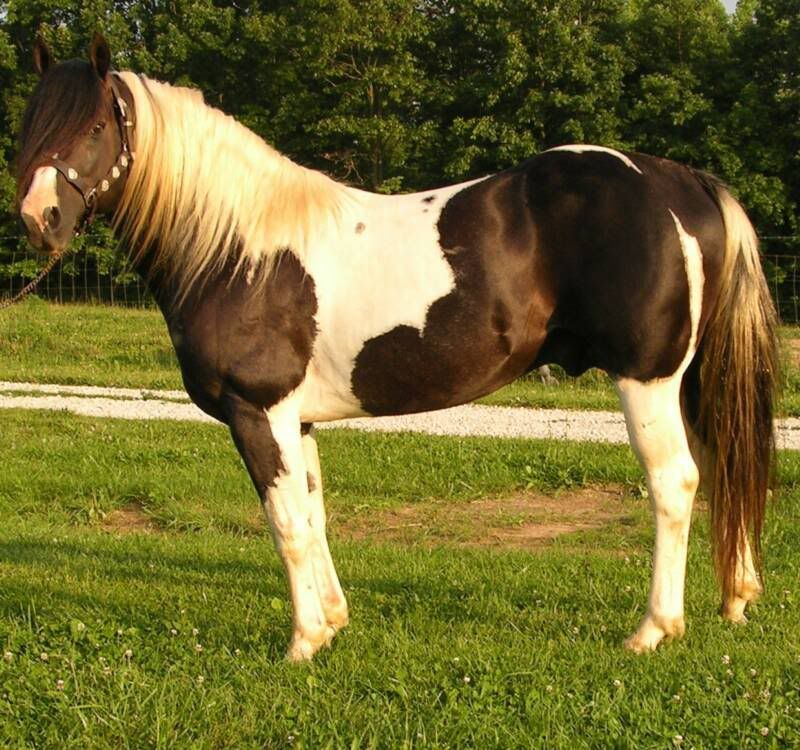 Pinto or Paint
This coloring is typically a horse with splashes, spots, or waves of white
and any other color over its body. Recognized patterns include Tobiano, Overo
Tovero, and Sabino.
Pinto or Paint
This coloring is typically a horse with splashes, spots, or waves of white
and any other color over its body. Recognized patterns include Tobiano, Overo
Tovero, and Sabino.
Tobiano markings are characterized by white legs, white around tail, white
across back between withers and tail, colored head with white facial markings,
(star, snip, strip, or blaze) and the spots are rounded.
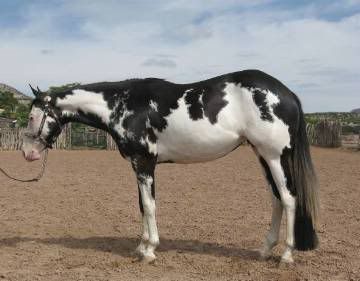 Overo markings are characterized by a white or "bald" face, often with blue eyes,
usually has colored legs, white rarely crosses the back, and spots are more sharp
or irregular.
Overo markings are characterized by a white or "bald" face, often with blue eyes,
usually has colored legs, white rarely crosses the back, and spots are more sharp
or irregular.
 Sabino markings may include belly spots, high white on legs, white markings on
face extending past the eyes, and roaning patterns standing alone or on the edges of
white markings.
Sabino markings may include belly spots, high white on legs, white markings on
face extending past the eyes, and roaning patterns standing alone or on the edges of
white markings.
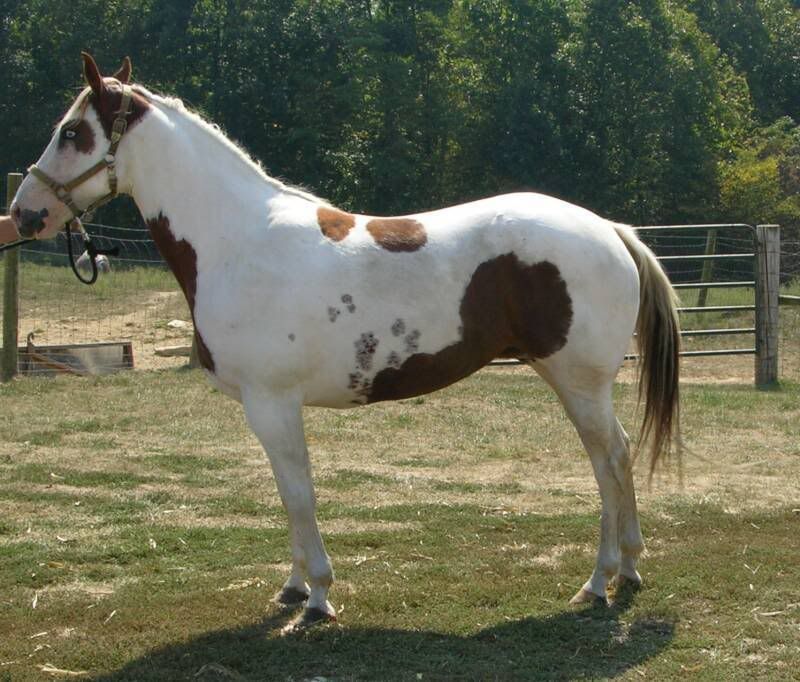 Tovero markings are mixture of Tobiano and Overo markings, such as blue eyes on a
dark head, a white face with dark patches around the eyes, etc.
Tovero markings are mixture of Tobiano and Overo markings, such as blue eyes on a
dark head, a white face with dark patches around the eyes, etc.
"Other Rare Colorations"
Brindle
This characteristic is very rare and looks like zebra stripes over the
body in a brown or yellowish color.
Champagne
This effect is produced by a
different dilution gene than the cream gene. It lightens the horse's skin and hair,
and creates a metallic sheen over the coat. Champagne horses can easily be
confused with palomino, cremello, Pinto Pinto dun, or buckskins.
Silver Dapple
Caused by a dilution gene that only acts upon black hair pigment,
it lightens black body hair to a chocolate brown and the mane and tail to silver.
The gene may be carried but will not be visible on horses with a red base coat.
More Horse Articles
|
|
|

